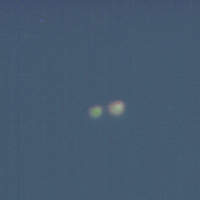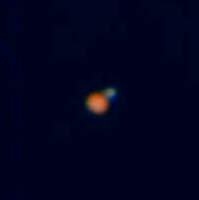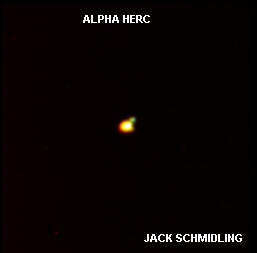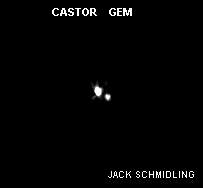![[Polaris]](polaris.jpg)
| Astrophotos | JSP Homepage |
The colors designated in the description are visual colors and do not necessarily represent what the film sees. North is up and position angles are referenced to North.
![[Alberio]](alberio.jpg)
![[Polaris]](polaris.jpg)



![[E1]](e1.jpg)
![[E2]](e2.jpg)
COMMENTS:
In order to achieve this sort of resolution, an EFL of about 100 feet was used. Just for reference that is about twice the length of the Yerkes 40" refractor. To gain the EFL, a 40X microscope objective was used as a projection lens onto the 4x5 film holder. This lens was about half the normal working distance used in a microscope so it produced about 25x over the 60" fl of the 10" Newt. Focusing under very high magnification presents a real challenge and is probably impossible with anything other than aerial viewing. There just isn't enough light for even the best viewing screens. The JSP Astrocamera uses a standard eyepiece for focusing so light is not a problem but picking the best focus is a bit daunting but a few test exposures provided the necessary feedback.
One would like to see the nice airy disk and ring pattern seen visually, but those views are just moments of perfect seeing and the chances of them lasting for a 5 second exposure are just about zero. The eye also ignores vibration and wind movements and does not suffer from image diffusion like film does.
In the April 1997 issue of Sky and Telescope there is one of Sissy Haas's articles on double stars. This one covers 13 doubles in Leo, ranging in separation from 1.5 to to 177 seconds of arc. Instead of the usual drawings of the pairs, this article is accompanied by a set of color photographs taken by me in the wee and fridgid hours of the early morning three months prior to publication. As my double star experience up to that time was all black and white, it was a real learning experience.
The entire set of photos for the article was processed and printed by me, scanned into the computer then uploaded to the web page on a special html. They were downloaded by the editor and ended up in the magazine without the use of a single stamp. In addition to the photos, are comments to help the editor interpret them. The position angles agree with the published numbers if you add 180 degrees.You can compare the digital images with the published ones on page 77 or the April issue.
To see these photos go to: Leo Doubles Photos
Omicron Eridini
Omicron Eridini is a remarkable triple star system. It contains one of the only white dwarfs
visible in small telescopes in addition to a red dwarf that represents one of the lowest mass
stars visible in any telescope.
The aparent separation of the A and B pair is about 83 arc seconds and about 9 arc seconds for the B and C pair.
The B component is the white dwarf with a diameter only about twice the size of the Earth and a mass about one half that of the Sun. This results in an average density of about
65,000 that of the Sun or about 2 tons to the cubic inch.
![[]](oeridini.jpg)
This photo was taken with the 10" Newt at EFL of 125".
The exposure was 5 min on TMax 400.
Although not an awe-inspiring photo op, close double stars make challenging subjects for photography. As great magnification is required to separate the pair, atmospheric conditions greatly affect the image. What one sees in a telescope is not always what one gets in a photo. The pair we have chosen is separated by only 2 arc seconds. We all know that a circle is divided up into 360 degrees and each degree is divided up into 60 minutes. That's were it ends for most of the day to day world but we are yet to divide each minute into 60 arc seconds, a tiny angle indeed. A nickle seen at a distance of a mile would subtend an angle of about 2 arc seconds. In a normal image taken through my telescope, this pair would simply appear as a single blob. Special optics are used to multiply the scale by a factor of about 5 to get the magnification shown in the image.
The two stars, Castor A and Castor B revolve about each other about every 400 years in an eliptical orbit. The separation, between the two varies with the relative location in the elipse, with a maximum of about 6.5 arc sec and a minimum of about 1.8. It is now near the minimum. The actual mean distance is about 8 billion miles or roughly the diameter of the entire Solar System.
To complicate matters even further, each "star" is also actually a double star but the components are far too close together to be resolved in a backyard telescope. They orbit each other in a few days, at a distance of a few million miles.
You probably don't want to hear this but there is another C component that orbits A and B at the enormous distance of about 100 billion miles in about 10,000 years. It happens to be a red dwarf also made up of two components.

CASTOR
Separation: ............. 2.1 arc seconds
Magnitude:............... A component= 1.9
Magnitude................ B component= 2.9
Dist From Earth....... 45 light years